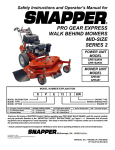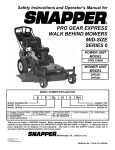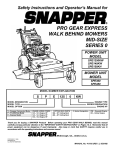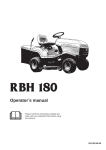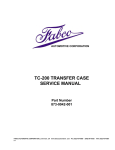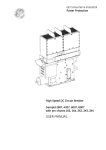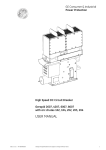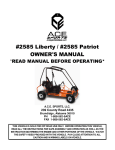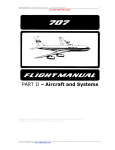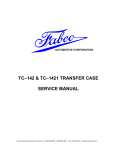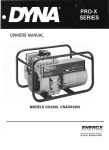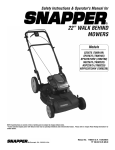Download Snapper SGV13321KW Lawn Mower User Manual
Transcript
Safety Instructions and Operator’s Manual for PRO SERIES WALK BEHIND MOWER SERIES 1 MODEL SGV13321KW MODEL NUMBER EXPLANATION S GV 13 MODEL DESIGNATION MODEL TYPE ENGINE HP * S – Snapper GV – Model Designation 32 1 KW ENGINE TYPE SERIES DESIGNATION DECK SIZE 13 – 13 Engine HP 32 – 32” Cutting Deck 1 – Series Designation KW – Kawasaki Engine Thank you for buying a SNAPPER Product! Before operating your PRO SERIES WALK BEHIND, read this manual carefully and pay particular attention to the “IMPORTANT SAFETY INSTRUCTIONS” on Pages 2 - 4. Remember that all power equipment can be dangerous if used improperly. Also keep in mind that SAFETY requires careful use in accordance with the operating instructions and common sense! * Actual sustained equipment horsepower will likely be lower due to operating limitations and environmental factors. COPYRIGHT © 2005 SNAPPER – A Division of Simplicity Manufacturing, Inc. ALL RIGHTS RESERVED MANUAL No. 7-8176 (I.R. 1/24/05) IMPORTANT SAFETY INSTRUCTIONS WARNING: This powerful cutting machine is capable of amputating hands and feet and can throw objects that can cause injury and damage! Failure to comply with the following SAFETY instructions could result in serious injury or death to the operator or other persons. The owner of the machine must understand these instructions and must allow only persons who understand these instructions to operate machine. Each person operating the machine must be of sound mind and body and must not be under the influence of any substance, which might impair vision, dexterity or judgment. If you have any questions pertaining to your machine which your dealer cannot answer to your satisfaction, call or write the Customer Service Department at SNAPPER, McDonough, Georgia 30253. Phone: (1-800-935-2967). PROTECTION FOR CHILDREN SLOPE OPERATION Tragic accidents can occur if the operator is not alert to the presence of children. Children are often attracted to the machine and the mowing activity. Never assume that children will remain where you last saw them. 1. KEEP children out of the mowing area and under the watchful care of a responsible adult. 2. DO NOT allow children in yard when machine is operated (even with the blades OFF). 3. DO NOT allow children or others to ride on machine, attachments, or towed equipment (even with the blades OFF). They may fall and be seriously injured. 4. DO NOT allow pre-teenage children to operate or service the machine. Local regulations may restrict the age of the operator. 5. ALLOW only adults or responsible teenagers with mature judgment under close adult supervision to operate machine. 6. DO NOT operate blades in reverse. STOP BLADES. LOOK and SEE behind and down for children, pets and hazards before and while backing. 7. USE EXTRA CARE when approaching blind corners, shrubs, trees, or other objects that may obscure vision. (Continued From Previous Column) 8. Always keep the machine in gear when going down slopes. DO NOT shift to neutral (or actuate the hydro roll release) and coast down hill. SLOPE OPERATION 1. Slopes are a major factor related to slip and fall accidents, which can result in severe injury. All slopes require extra caution and slow speed. If you feel uneasy on a slope, DO NOT mow it. 2. Mow across slopes, never up and down. Exercise extreme CAUTION when changing directions on slopes. Practice operation of machine on slopes with blades off. 3. Use extra care with grass catchers or other attachments: these affect the handling and the stability of the machine. 4. DO NOT use tow behind attachments on slopes. 5. AVOID uphill starts. 6. Turf conditions can affect the machine’s stability. DO NOT operate machine under any condition where traction, steering or stability is doubtful. 7. Chose a low enough ground speed setting so that you will not have to stop or shift on a slope. Tires may lose traction on slopes even though the brakes are functioning properly. PREPARATION 1. Read, understand and follow instructions and warnings in this manual and on the machine, engine, and attachments. Know the controls and the proper use of the machine before starting. If the operators or mechanics cannot read English, it is the owner’s responsibility to explain this material to them. 2. Only mature, responsible persons shall operate the machine and only after proper instruction. The owner is responsible for training the operators. Further, the owner/operator can prevent and/or is responsible for accidents or injuries occurring to themselves, other people or property. 3. Data indicates that operators age 60 and above, are involved in a large percentage of mower-related injuries. These operators should evaluate their ability to operate the mower safely enough to protect themselves and others from serious injury. 4. Handle fuel with extra care. Fuels are flammable and vapors are explosive. Use only an approved fuel container. DO NOT remove fuel cap or add fuel with engine running. Add fuel outdoors only with engine stopped and cool. Clean spilled fuel from machine. DO NOT smoke. 5. Practice operation of machine with BLADES OFF to learn controls and develop skills. 6. Check the area to be mowed and remove all objects such as toys, wire, rocks, limbs and other objects that could cause injury if thrown by blade or interfere with mowing. 7. Evaluate the terrain to determine what accessories and attachments are needed to properly and safely perform the job. Only use accessories and attachments approved by SNAPPER. 8. Keep people and pets out of mowing area. Immediately, STOP blades, STOP engine, and Stop machine if anyone enters the area. 9. DO NOT operate machine unless all shields, deflectors, switches, blade controls and other safety devices are in place and functioning properly. 10. Make sure all safety decals are clearly legible. Replace if damaged. IMPORTANT SAFETY INSTRUCTIONS PREPARATION OPERATION (Continued From Previous Page) 11. Protect yourself when mowing and wear appropriate clothing including safety glasses, long pants, ear protection, hardhat and substantial footwear with good traction. Long hair, loose clothing or jewelry may get tangled in moving parts. 12. Know how to STOP blades and engine quickly in preparation for emergencies. 13. Use extra care when loading or unloading the machine into a trailer or truck. 14. Check grass catcher components frequently for signs of wear or deterioration and replace as needed to prevent injury from thrown objects going through weak or worn spots. (Continued From Previous Column) 3. Stop Blades when crossing gravel drive, walks, and under any conditions where thrown objects might be a hazard. 4. DO NOT raise deck with the blades running. 5. Mow only in daylight or good artificial light. 6. USE EXTRA CARE when approaching blind corners, shrubs, trees or other objects that may obscure vision. 7. DO NOT operate the machine while under the influence of alcohol or drugs. 8. After striking a foreign object or if the mower vibrates abnormally, STOP the blades and engine. Remove the key. Disconnect and secure the spark plug wire. Inspect the mower for any damage and repair the damage. 9. DO NOT operate machine near drop offs, ditches, embankments, washouts culverts, fences and protruding objects. STAY ALERT for holes and other hidden hazards. Tall grass can hide obstacles. 10. DO NOT operate machine on wet grass. Always be sure of your footing while operating machine, especially while backing up. Keep a firm grip on the handle. Walk: never run. Slipping and falling could cause injury. 11. DO NOT leave the machine with the engine running. STOP BLADES, STOP ENGINE and REMOVE KEY before leaving the operator position for any reason. 10. Before cleaning, repairing, or inspecting make certain blades, engine and all moving parts have STOPPED. Remove key and secure spark plug wire away from spark plug key to prevent accidental starting. 12. STOP MACHINE on level ground, engage parking brake (if equipped) and make sure engine and blades have stopped before leaving the operator’s position for any reason including removing grass catcher or unclogging mower to prevent injury to hands or feet. 13. Blades must be OFF except when cutting grass. Set blades in highest position when mowing over rough ground. 14. Keep hands and feet away from rotating blades underneath deck. 15. DO NOT operate machine without entire grass catcher or guards in place. DO NOT point discharge at people, passing cars, windows or doors. 16. Slow down before turning. 17. Watch out for traffic when near or crossing roadways. 18. Move motion control levers SLOWLY to maintain control during speed and directional changes. 19. DO NOT operate engine in enclosed areas. Engine exhaust gases contain carbon monoxide, a deadly poison. SAFE HANDLING OF GASOLINE To avoid personal injury or property damage, use extreme care in handling gasoline. Gasoline is extremely flammable and the vapors are explosive 1. Extinguish all cigarettes, cigars, pipes and other sources of ignition. 2. Use only an approved fuel container. 3. DO NOT remove fuel cap or add fuel with the engine running. Allow the engine to cool before refueling. 4. DO NOT refuel the machine indoors. 5. DO NOT store the machine or fuel container inside where there is an open flame, spark or pilot light such as on a water heater or other appliances. 6. DO NOT fill fuel containers inside a vehicle or on a truck or trailer bed with a plastic liner. Always place the containers on the ground away from the vehicle before filling. 7. Remove gas-powered equipment from the vehicle or trailer and refuel it on the ground. If this is not possible, then refuel equipment using a portable container, rather than a gasoline dispenser nozzle. 8. DO NOT start gas powered equipment in enclosed vehicles or trailers. 9. Keep the nozzle in contact with the rim of the fuel tank or container opening at all times until fueling is complete. DO NOT use a nozzle lock-open device 10. If fuel is spilled on clothing, change clothing immediately. 11. DO NOT overfill a fuel tank. Replace fuel cap and tighten securely. OPERATION 1. DO NOT put hands or feet near or under rotating parts. Keep clear of the discharge area while the engine is running. 2. BEFORE STARTING ENGINE, blades must be OFF and Traction Levers LOCKED in the Traction Lock position. 3 IMPORTANT SAFETY INSTRUCTIONS MAINTENANCE 1. Shut off fuel while storing or transporting. DO NOT store machine or fuel container inside where fumes may reach an open flame, spark or pilot light such as in a water heater, furnace, clothes dryer or other gas appliance. Allow engine to cool before storing machine in an enclosure. Store fuel container out of the reach of children in a well ventilated, unoccupied building. 2. Clean grass and debris from engine, mufflers, drives and cutting units to help prevent fires. Clean up fuel, oil and excess grease. 3. When draining fuel tank, drain fuel into an approved container outdoors and away from open flame. 4. Check brakes frequently (if equipped); adjust, repair or replace as needed. 5. Keep all bolts, nuts and screws properly tight. Check that all cotter pins are in proper position. 6. Always provide adequate ventilation when running engine. Exhaust gases contain carbon monoxide, an odorless and deadly poison 7. Disconnect battery before performing maintenance or service. Cranking engine could cause injury. Disconnect negative (black) cable from battery first and positive (red) last. Reconnect positive first and negative last. Charge battery in an open well ventilated area, free from spark and flames. Unplug charger before connecting or disconnecting from battery. Wear protective clothing and insulated gloves. 8. Park machine on level ground. DO NOT work under machine without safety blocks. 9. Service engine and clean, adjust or repair only when engine and blades are stopped. Remove key. Remove spark plug wire(s) from spark plug(s) and secure wire(s) away from spark plug(s). 10. DO NOT change engine governor speed settings or overspeed engine. DO NOT make adjustments with the engine running. 11. Lubricate machine at intervals specified in manual to prevent controls from binding. 12. Mower blades are sharp and can cut. Wrap the blades or wear heavy leather gloves and use CAUTION when handling them. DO NOT straighten or weld blades, only replace them. 13. DO NOT test for spark by grounding spark plug next to spark plug hole; spark plug could ignite gas exiting engine. 14. Carefully release pressure from components with stored energy. 15. Have machine serviced by an authorized SNAPPER dealer at least once a year and have the dealer install any new safety devices. DO NOT allow untrained personnel to service the machine. 16. Use only genuine SNAPPER replacement parts to assure that original standards are maintained. 4 TABLE OF CONTENTS IMPORTANT SAFETY INSTRUCTIONS ..................................................................................2-4 TABLE OF CONTENTS ............................................................................................................... 5 SECTION 1 – FAMILIARIZATION ............................................................................................6-7 SECTION 2 – DECAL IDENTIFICATION..................................................................................7-8 SECTION 3 – OPERATING INSTRUCTIONS ........................................................................9-14 Before Operating............................................................................................................ 9 Controls & Their Functions......................................................................................9-10 Pre-Start Checklist....................................................................................................... 11 Starting Engine .......................................................................................................11-12 Machine Movement.................................................................................................12-14 Cutting Blade Operation.............................................................................................. 14 Stopping Machine ........................................................................................................ 14 Mowing and Turning on Hillsides .............................................................................. 14 SECTION 4 – TROUBLESHOOTING ...................................................................................15-16 Engine Troubleshooting.............................................................................................. 15 Mower Troubleshooting .........................................................................................15-16 Transmission Troubleshooting .................................................................................. 16 SECTION 5 – MAINTENANCE .................................................................................................. 17 General Maintenance Schedule.................................................................................. 17 Safety Interlock System Checks................................................................................. 17 SECTION 6 – ADJUSTMENTS & REPAIRS ........................................................................18-23 Lower Traction Rod Adjustment ................................................................................ 18 Upper Traction Rod Adjustment ................................................................................ 18 Traction Idler Spring Adjustment............................................................................... 18 Handle Height Adjustment .......................................................................................... 19 Transmission Shift Indicator Adjustment ................................................................. 19 Cutting Height Adjustment ....................................................................................19-20 Deck Belt Adjustment & Replacement....................................................................... 20 Transmission Belt Adjustment & Replacement........................................................ 21 Traction Belt Replacement ....................................................................................21-22 Replacement Parts....................................................................................................... 22 Transmission Parts & Service .................................................................................... 22 Cutting Blade Service: Removal, Sharpening, Balancing & Replacement ............ 23 SECTION 7 – ELECTRICAL ...................................................................................................... 24 WARRANTY AND PRODUCT REGISTRATION..................................................................25-26 PRIMARY MAINTENANCE...................................................................................................27-30 5 SECTION 1 – FAMILIARIZATION DASHBOARD SEE FIGURE 1.2 FUEL CAP IMPORTANT The figures and illustrations in this manual are provided for reference only and may differ from your specific model. Contact your Snapper dealer if you have questions. OPERATOR’S PRESENCE CONTROL (OPC) (L&R) FUEL TANK TRACTION LOCK (L&R) TRACTION LEVER (L&R) STARTER ROPE TRANSMISSION SHIFT LEVER AIR FILTER DECK COVER DISCHARGE DEFLECTOR MUFFLER DECK HEIGHT ADJUSTMENT SPACERS REAR TIRE COVER RETAINING STRAP (2) CUTTING DECK FRONT CASTER ASSEMBLY (2) FIGURE 1.1 1.2 NOMENCLATURE It is recommended that all operator’s of this equipment become thoroughly familiar with the controls, components, and operation of this machine before operating. Specific details involving the engine are found in the separate engine owner’s manual. Study these manuals before operating and keep both handy for future reference. For the nearest SNAPPER dealer in your area, check the yellow pages under the heading LAWN MOWERS. For engine parts and service, look for the engine manufacturer’s dealers under the heading, ENGINES - gasoline. 1.1 INTRODUCTION This manual has been prepared for the operator’s of the SNAPPER PRO SERIES WALK BEHIND MOWER. Its purpose, aside from recommending standard operating procedures and routine service requirements, is to promote SAFETY through the use of accepted operating practices. Read, Understand and Follow the IMPORTANT SAFETY INSTRUCTIONS on Pages 2 thru 4 of this manual and All SAFETY messages on the PRO SERIES WALK BEHIND MOWER and its attachments before operating. SNAPPER recommends returning the MACHINE to an authorized SNAPPER dealer annually for inspection and addition of any new devices which might upgrade the safety of the mower. 6 SECTION 1 – FAMILIARIZATION LEFT HAND TRACTION LOCK ENGINE SPEED CONTROL/ CHOKE CONTROL BLADE CLUTCH SWITCH KEY SWITCH RIGHT HAND TRACTION LOCK RIGHT HAND OPERATOR’S PRESENCE CONTROL (OPC) LEFT HAND OPERATOR’S PRESENCE CONTROL (OPC) RIGHT HANDLE GRIP LEFT HANDLE GRIP LEFT HAND TRACTION LEVER REVERSE LOCKOUT LEVER RIGHT HAND TRACTION LEVER TRANSMISSION SHIFT LEVER CONTROL LOCATIONS FIGURE 1.2 SECTION 2 – DECAL IDENTIFICATION DASHBOARD OVERLAY 7 SECTION 2 – DECAL IDENTIFICATION DANGER! ROTATING BLADES KEEP CHILDREN AND OTHERS OUT OF THE MOWING AREA HEARING PROTECTION CAUTION! OPEN BELT DRIVE DANGER! ROTATING BLADES TRANSMISSION SHIFT INDICATOR IMPORTANT SAFETY AND OPERATING INSTRUCTIONS 8 SECTION 3 – OPERATING INSTRUCTIONS WARNING DO NOT allow operation of the machine by untrained personnel. IMPORTANT! BEFORE OPERATING: Be thoroughly familiar with all controls and how to use them before operating the machine. Know beforehand how to STOP machine motion, mower blades and engine in preparation for possible emergencies. HANDLE GRIP 3.1 CONTROLS & THEIR FUNCTIONS 3.1.1. OPERATOR PRESENCE CONTROL (OPC) The Operator Presence Control (OPC) is designed to kill the engine should the operator release the handles while the mower blades are engaged and/or the transmission is in forward or reverse gear. The OPC is activated by depressing one or both of the OPC handles located over the left and right handle grips. See Figure 3.1. TRACTION LEVER FIGURE 3.2 (Left hand shown; right hand identical) WARNING To avoid sudden and unexpected turning, both Traction Levers must be depressed or released at the same time when stopping or starting machine motion. WARNING When the Operator’s Presence Control (OPC) is released, the machine will continue to operate a few feet. DO NOT use this Operator’s Presence Control (OPC) to routinely stop the machine. 3.1.3. TRACTION LOCKS The Traction Locks lock the wheel brakes to prevent movement of the machine. See Figure 3.3. 1. To lock: Firmly squeeze both traction levers against the handle grip, and with both thumbs, push the tab atop each traction lock forward. Slowly release the traction lever, checking to be sure that the locks have held. 2. To unlock: Firmly squeeze both traction levers against the handle grip and release. The locks are spring-loaded, and will automatically disengage. WARNING DO NOT attempt to modify, remove, or otherwise alter the OPC in any way. Doing so may result in serious injury or death. OPC HANDLE PUSH TRACTION LOCK FORWARD TRACTION LEVER SHOWN IN LOCKED POSITION HANDLE GRIP FIGURE 3.1 (Left hand shown; right hand identical) SQUEEZE TRACTION LEVER FIGURE 3.3 (Right hand shown; left hand identical) 3.1.2. TRACTION LEVERS The Traction Levers control both the stopping and turning of the machine. See Figure 3.2. When squeezed, the lever simultaneously declutches the traction belt while applying the wheel brake. Squeezing the left lever turns the machine to the left, squeezing the right lever turns the machine to the right, squeezing both left and right levers together stops the machine. 11 9 SECTION 3 – OPERATING INSTRUCTIONS 3.1 CONTROLS & THEIR FUNCTIONS PULL UP TO ENGAGE (continued) 3.1.4. KEY SWITCH The Key Switch provides or cuts power to the engine. See Figure 3.4. 1. To run engine, turn key to ‘RUN’. 2. To stop engine, turn key to ‘STOP’. ENGINE “STOP” PUSH DOWN TO DISENGAGE FIGURE 3.6 ENGINE “RUN” 3.1.7. TRANSMISSION SHIFT LEVER The Transmission has five forward speeds and one reverse speed. 1. To engage transmission in a forward gear, move the transmission shift lever from the neutral (‘N’) position into the desired gear (‘1’ – ‘5’). See Figure 3.7. FIGURE 3.4 3.1.5. ENGINE SPEED & CHOKE CONTROL The Engine Speed Control controls the speed of the engine. A built-in Choke Control, above the engine speed range, assists in starting a cold engine. See Figure 3.5. CHOKE ‘FAST’ FIGURE 3.7 2. To engage transmission in reverse, lift up on reverse lockout lever, and move transmission shift lever from the neutral (‘N’) position into reverse (‘R’) gear. See Figure 3.8. ‘SLOW’ FIGURE 3.5 3.1.6. BLADE CLUTCH SWITCH The Blade Clutch Switch engages and disengages cutting blade clutch. Pulling the switch knob up to ‘ON’ position engages the blade clutch. Pushing switch knob down to the ‘OFF’ position disengages blade clutch. See Figure 3.6. the the the the FIGURE 3.8 12 10 SECTION 3 – OPERATING INSTRUCTIONS 3.2 PRE-START CHECK LIST Make the following checks and perform the services as required before each start-up: 1. If required, make cutting height adjustments. Refer to Section “CUTTING HEIGHT ADJUSTMENT”. 2. Check tires and add air as needed to bring pressure to 25 psi in front and 12-15 psi in rear tires. 3. Check Guards, Deflector, and Belt Covers to make sure all are in place and secure. 4. Check Condition of Blade Deck Belt. If damaged, replace before operating machine. Refer to Section “DECK BELT ADJUSTMENT & REPLACEMENT”. 5. Clean Interior and Exterior Surfaces of cutting deck and clean Engine of any accumulation of dirt, grass, oil, etc. Keep Engine air intake screens and cooling fins clear at all times. 6. Check Engine Oil and add oil as needed to bring level up to (but not over) the FULL mark. (Refer to Engine manual for oil specifications). 7. Add Fuel to tank after pushing the Mower outside where fumes can be dissipated. Make sure Fuel Tank Cap is tightened after refueling. (Refer to Engine manual for fuel specifications). PUSH TRACTION LOCK FORWARD TRACTION LEVER SHOWN IN LOCKED POSITION SQUEEZE TRACTION LEVER FIGURE 3.10 3. Move Transmission Shift Lever into NEUTRAL (N) position. See Figure 3.11. NOTE: DO NOT add fuel while engine is running or hot. Use fresh, clean, lead-free gasoline. DO NOT use gasoline that has been stored for long periods. Leaded gasoline or gasohol is NOT recommended. 3.3 STARTING ENGINE 1. Turn Fuel Shut-Off Valve ON. See Figure 3.9. CLOSED (OFF) FIGURE 3.11 4. Push Blade Clutch Switch down to the ‘OFF’ position. See Figure 3.12. OPEN (ON) FIGURE 3.9 2. Lock Traction Levers by squeezing both Traction Levers against the handle grips while pushing right and left Traction Locks forward until BOTH Traction Levers are in the locked position. See Figure 3.10. PUSH SWITCH KNOB DOWN FIGURE 3.12 IMPORTANT! Always make sure that both left and right Traction Locks are in the same position before moving or releasing Traction Levers. (Continued on next page) 11 SECTION 3 – OPERATING INSTRUCTIONS NOTE: Engine will not start unless transmission is in NEUTRAL position and Blade Clutch Switch is in OFF position. 3.3 STARTING ENGINE 5. (Continued from previous page) Move Engine Speed Control fully up to CHOKE position. See Figure 3.13. WARNING DO NOT leave machine with engine running. Stop engine. Stop blades. Lock traction levers. Remove key. DO NOT park machine on slopes. 3.4 MACHINE MOVEMENT 3.4.1. FORWARD MOTION. 1. With both traction levers locked, depress Operator’s Presence Control (OPC) against handle. See Figure 3.16. FIGURE 3.13 6. Turn Key Switch to RUN position. See Figure 3.14. ENGINE “RUN” FIGURE 3.16 (Right hand shown; left hand identical) 2. Move Transmission Shift Lever in No. 1 position (first gear). See Figure 3.17. FIGURE 3.14 7. Pull Recoil Starter Handle and Engine should start. See Figure 3.15. (NOTE: Several pulls may be necessary to start engine.) IMPORTANT: DO NOT jerk the engine recoil starter handle or allow it to snap back. FIGURE 3.17 3. Squeeze both Traction Levers firmly against handle grips. Traction Locks are spring-loaded and will snap back to the “Unlocked” position. Using caution, slowly and simultaneously release pressure on both Traction Levers. The machine will begin to move forward. FIGURE 3.15 8. After engine starts, move Engine Speed Control back to FAST (rabbit) position. (Continued on next page) 12 SECTION 3 – OPERATING INSTRUCTIONS 3.4 MACHINE MOVEMENT (Continued from previous page) NOTE: Releasing the Operator’s Presence Control (OPC) while Transmission is in GEAR and/or Blades are ON will ground the Ignition Circuit and cause the Engine to STOP, allowing the Machine to travel only a few feet before coming to a complete STOP. SQUEEZE LEFT TRACTION LEVER TO TURN LEFT WARNING During initial training time with machine, it is advised that the operator(s) practice all mower movements while operating the mower with the transmission shift lever in no. 1 (first gear) travel speed position and blade clutch switch in off position! DO NOT make sharp turns at high speeds! SQUEEZE BOTH TRACTION LEVERS SIMULTANEOUSLY TO STOP MACHINE SQUEEZE RIGHT TRACTION LEVER TO TURN RIGHT FIGURE 3.18 3.4.3. REVERSE MOTION. 1. With both Traction Levers locked, depress Operator’s Presence Control (OPC) against handle. See Figure 3.19. 2. Lift up on reverse lockout lever, and move transmission shift lever from the neutral (‘N’) position into reverse (‘R’) gear. See Figure 3.19. IMPORTANT: Always STOP machine movement and lock traction levers before changing to a different ground speed. Transmission damage could result if ground speed is changed when machine is moving. 3.4.2. TURNING AND BRAKING. WARNING Machine should always be in forward motion before attempting a turn. DO NOT attempt a turn from a stopped position. 1. To Turn Left, gradually squeeze left Traction Lever against handle grip. See Figure 3.18. NOTE: The harder the lever is squeezed, the sharper the turn will be. 2. To Turn Right, gradually squeeze right Traction Lever against handle grip. See Figure 3.18. NOTE: The harder the lever is squeezed, the sharper the turn will be. 3. To Stop Machine Motion, squeeze both Traction Levers firmly against handle grips. See Figure 3.18. NOTE: The harder the levers are squeezed, the harder the stop will be. FIGURE 3.19 3. Squeeze both Traction Levers firmly against handle grips. Traction Locks are spring-loaded and will snap back to the “Unlocked” position. Using caution, slowly and simultaneously release pressure on both Traction Levers. The machine will begin to move in reverse. WARNING Brakes require maintenance. Inspect for proper operation before operating machine. Refer to Section “ADJUSTMENTS, LOWER TRACTION ROD ADJUSTMENT”. WARNING DO NOT operate blades in reverse. Stop blades. LOOK and SEE behind and down for children, pets and hazards before and while backing. Engine speed must be set to SLOW before operating in reverse. WARNING To avoid sudden and unexpected turning, both Traction Levers must be depressed or released at the same time when stopping or starting machine motion. (Continued on next page) 13 SECTION 3 – OPERATING INSTRUCTIONS 5. Push Blade Clutch Switch down to the OFF position when finished mowing. See Figure 3.20. NOTE: Turn off blades as soon as mowing operation is complete. 3.4 MACHINE MOVEMENT (Continued from previous page) NOTE: Releasing the Operator’s Presence Control (OPC) while Transmission is in GEAR and/or Blades are ON will ground the Ignition Circuit and cause the Engine to STOP, allowing the Machine to travel only a few feet before coming to a complete STOP. 3.6 STOPPING MACHINE 1. 2. 3.5 CUTTING BLADE OPERATION 1. 2. 3. 3. Start engine. Refer to Section “STARTING ENGINE”. With both Traction Levers locked, depress Operator’s Presence Control (OPC) against handle. See Figure 3.16. Pull Blade Clutch Switch up to the ON position. See Figure 3.20. 4. 5. Lock both Traction Levers. Push the Blade Clutch Switch down to the OFF position. Move the Transmission Shift Lever into the NEUTRAL (N) position. Move engine speed control to SLOW (Turtle) position. Stop engine. Turn key switch to “STOP” position. Remove key. 3.7 MOWING AND TURNING ON HILLSIDES PULL SWITCH UP TO ENGAGE BLADES 1. Always mow hillsides starting at bottom of hill. Mow across slopes, never up and down. Exercise caution when changing directions on slopes. DO NOT mow steep slopes! WARNING DO NOT mow on steep slopes. DO NOT use with any type rider attachment on slopes. DO NOT park machine on slopes. PUSH SWITCH DOWN TO DISENGAGE BLADES 2. Hillside mowing is accomplished by squeezing Traction Lever on the UPHILL SIDE of machine. This helps reduce side slipping of mower. 3. When turning mower on hillsides, always turn toward the UPHILL SIDE of mower for better control and balance. FIGURE 3.20 4. Move the Transmission Shift Lever from Neutral (N) position into selected gear, and begin mowing operation. NOTE: Releasing the Operator’s Presence Control (OPC) while Transmission is in GEAR and/or Blades are ON will ground the Ignition Circuit and cause the Engine to STOP, allowing the Machine to travel only a few feet before coming to a complete STOP. WARNING Start mowing with a slow ground speed and gradually increase speed to determine the most comfortable travel speed. WARNING DO NOT operate blades in reverse. Stop blades. LOOK and SEE behind and down for children, pets and hazards before and while backing. Engine speed must be set to SLOW before operating in reverse. 14 SECTION 4 – TROUBLESHOOTING 4.1 ENGINE TROUBLESHOOTING SYMPTOM PROBLEM SOLUTION Engine....................Key OFF. .............................................................................................. Turn Key to Run. does not.................Fuel Tank empty................................................................................... Fill Fuel Tank. start........................Fuel Shut-Off Closed. ........................................................................... Open Fuel Shut-Off. ................................Engine Speed Control not at FAST (Rabbit) position............................ Move Engine Speed Control to FAST ................................Engine NOT Choked. ........................................................................... Move Engine Speed Control to CHOKE ................................ ............................................................................................................. position. ................................ ............................................................................................................. Check choke adjustment. ................................Spark Plug Wire loose or disconnected. ............................................... Connect Spark Plug Wire. ................................Operator Presence Control (OPC) out of adjustment ........................... Adjust OPC. ................................Blade Clutch Switch in ON position. ..................................................... Push Blade Clutch Switch to OFF position. ................................Spark Plug bad. .................................................................................... Install new Spark Plug. ................................Dirty Air Filter........................................................................................ Clean Air Filter. ................................Transmission not in NEUTRAL............................................................. Move Transmission Lever to NEUTRAL (N). Engine....................Dirt or water Fuel Tank. ........................................................................ Drain and clean Fuel Tank. Fill with Starts Hard fresh Fuel. or Loses.................Vent in Gas Cap plugged...................................................................... Clean Vent or install new Gas Cap. Power.....................Air Filter dirty. ....................................................................................... Clean or install new Air Filter. ................................Spark Plug not gapped correctly........................................................... Check and set Spark Plug gap. ................................Spark Plug bad. .................................................................................... Install new Spark Plug. Engine ...................Spark Plug bad. .................................................................................... Install new Spark Plug. Runs.......................Spark Plug not gapped correctly........................................................... Clean and set Spark Plug gap. Erratically. .............Fuel Filter plugged or dirty. ................................................................... Replace Fuel Filter. Engine ...................Dirty Air Filter........................................................................................ Clean or replace Filter. Idles Poorly. ..........Fuel Filter plugged................................................................................ Replace Fuel Filter. Engine ...................Engine Oil low in Crankcase. ................................................................ Add Oil. Overheats. .............Engine Cooling Fins clogged ................................................................ Clean Engine Cooling Fins. Machine ................Blade Mounting Bolts loose. ................................................................. Tighten Blade Mounting Bolts. Vibrates .................Blade out of Balance. ........................................................................... Sharpen and balance Blade. Excessive. .............Engine Mounting Bolts loose. ............................................................... Tighten Mounting Bolts. ................................Damaged or Severed Belt .................................................................... Replace Belt. Engine....................Mowing grass too tall. ........................................................................... Adjust cutting height. Dies.. ......................Mowing too fast. ................................................................................... Reduce travel speed. 4.2 MOWER TROUBLESHOOTING SYMPTOM PROBLEM SOLUTION Mower does.............. Transmission in neutral. .................................................................... Select Gear. not move................... Traction Belt(s) slipping..................................................................... Adjust or replace Traction Idler Spring(s). when Traction ......... .......................................................................................................... Adjust Upper Traction Rod(s). Levers released ....... .......................................................................................................... Replace Traction Belt(s). ................................... Transmission Belt slipping ................................................................ Adjust Transmission Idler. ................................... .......................................................................................................... Replace Transmission Belt. ................................... Transmission Belt Damaged or Broken............................................. Replace Transmission Belt. Mower does.............. Slipping or broken Traction Belt. ....................................................... Adjust or replace Traction Belt. not track ................... Tire pressure in both Drive Wheels ................................................... Adjust air pressure. straight. .................... not the same. Mower veers ............. Wheel Brake(s) not engaging properly.............................................. Adjust Lower Traction Rod(s). when ......................... Traction Belt(s) not declutching......................................................... Adjust Upper Traction Rod(s). stopping. Mower does.............. Wheel Brake(s) not engaging properly.............................................. Adjust Lower Traction Rod(s). not stop when .......... Traction Belt(s) not declutching......................................................... Adjust Upper Traction Rod(s). Traction Levers are squeezed. 15 SECTION 4 – TROUBLESHOOTING 4.2 MOWER TROUBLESHOOTING (Continued) SYMPTOM PROBLEM SOLUTION Blades DO ......................................Deck Belt slipping or broken. ....................................... Adjust or Replace Deck Belt. NOT engage. ..................................Blade Clutch does not engage..................................... Check Electrical Connections & Clutch Mower .............................................Travel speed too fast. .................................................. Reduce ground speed. mows ..............................................Operator making mower turn corner too fast ............... Reduce ground speed. unevenly. ........................................Rough terrain............................................................... Change mowing pattern. .........................................................Unequal number of Blade Spacers on .............................................................. Cutter Shafts or Caster Wheels.............................. Install equal number of Spacers. .........................................................Low Or No Air Pressure in Tires .................................. Fill Tires with Correct Air Pressure. .........................................................Dull Blades .................................................................. Sharpen Blades or Install new Blades. Mower not.......................................Broken or slipping Deck Belt........................................ Adjust or Replace Deck Belt. cutting full ......................................Dull, Damaged or Worn Cutting Blades ....................... Sharpen Blades or Install new Blades width. Discharge .......................................Grass wet. ................................................................... Let Grass dry. Deflector Becomes ........................Cutting height too low .................................................. Raise cutting height Obstructed. ....................................Engine overloaded....................................................... Set engine speed to FAST and reduce travel speed. 4.3 TRANSMISSION TROUBLESHOOTING SYMPTOM PROBLEM SOLUTION Unit is .............................................Gearing is overly noisy - chatter, etc............................ Return to Authorized Snapper Dealer Noisy...............................................Worn Gears. .........................................................Worn Bearings - mainly Input Shaft .........................................................Ball Bearing. Unit Jumps .....................................Teeth of Gears are worn beyond tolerances................ Return to Authorized Snapper Dealer Out of Gear. 16 SECTION 5 – MAINTENANCE 5.1 GENERAL MAINTENANCE SCHEDULE HOURS PROCEDURE COMMENTS BREAK-IN .......................................Check all Grease Points and add if necessary. .........................................................Check all Fasteners for proper tightness. .........................................................Change Engine Oil and Filter at 5 hours...................... (See Engine Manual) DAILY ..............................................Check Engine Oil......................................................... Change Oil if extreme dusty conditions. .........................................................Clean Air Filter............................................................. More often if needed. .........................................................Clean Air Intake Screen............................................... More often if needed. .........................................................Remove Debris from under Belt Cover. ....................... More often if needed. .........................................................Sharpen Cutting Blades............................................... Tighten to 60-75 Ft.-Lbs. .........................................................Grease Cutting Blade Spindle Bearings. ..................... Use Chevron SRI Grease or equal. ......................................................... .................................................................................... (NLGI No. 2) .........................................................Inspect Interlock Switch for Damage ........................... Replace if Needed. .........................................................Inspect Belts for Wear or Damage............................... Replace if Needed. .........................................................Inspect brakes. ............................................................ Adjust for proper steering / stopping. WEEKLY .........................................Check Tire Pressure.................................................... Add or Adjust as required. .........................................................Check Safety Interlock System. ................................... Inspect OPC Switch for proper Operation. .........................................................Inspect Traction Lock for Wear.................................... Replace if Worn. .........................................................Change Engine Oil and Filter....................................... More often if needed. .........................................................Replace Air Filter. ........................................................ More often if needed. .........................................................Inspect Fuel Filter. ....................................................... Replace with SNAPPER P.N. 1-4359. .........................................................Lube Traction Levers. .................................................. One Shot General Purpose Grease. .........................................................Grease Caster Wheel Bearings. .................................. General Purpose Grease. .........................................................Grease Caster Support Arms. ..................................... General Purpose Grease. .........................................................Grease Drive Wheels. ................................................. General Purpose Grease. .........................................................Grease Wheel Brake Arms (below lower traction rods) ......................................................... .................................................................................... General Purpose Grease. .........................................................Grease Traction Idlers & Pulleys ................................. General Purpose Grease. MONTHLY.......................................Clean and Adjust Spark Plugs. .................................... (See Engine Manual) .........................................................Lube Controls and Linkages. ....................................... Use Medium Duty Oil. 5.2 SAFETY INTERLOCK SYSTEM CHECK This machine is equipped with an electrical safety interlock system that is provided for the safety of the operator and others. All safety devices must be in place and functioning properly before operating the machine. Perform the following interlock system checks periodically during the operating season. Contact your authorized Snapper dealer if you have questions. 2. Depress right and left Operator’s Presence Controls against handle. DO NOT move the Traction Levers to the “Unlocked” position. 3. Pull Blade Clutch Switch up to the “On” position. Release right and left Operator’s Presence Controls. The engine and blades must begin to stop. Depress both Operator’s Presence Controls before engine and blades come to a complete stop. 4. Push Blade Clutch Switch down to the “Off” position. 5. Move Transmission Shift Lever to first gear (‘1’). Release right and left Operator’s Presence Controls. The engine must begin to stop. Depress both Operator’s Presence Controls before engine comes to a complete stop. 6. Return Transmission Shift Lever to Neutral ‘N’ position. 7. Turn Key Switch to “Stop” position. Engine must die. WARNING DO NOT operate machine if any safety interlock or safety device is not in place and functioning properly. DO NOT attempt to defeat, modify or remove any safety device. 1. Place right and left Traction Levers in the Traction Locked position. Move Transmission Shift Lever in Neutral (‘N’). Push the Blade Clutch Switch down to the “Off” position. Refer to Section “Starting and Operation”. Start engine. 17 SECTION 6 – ADJUSTMENTS & REPAIRS 6.1 LOWER TRACTION ROD ADJUSTMENT If mower does not stop firmly when Traction Levers are squeezed, or if mower veers to one side when Traction Levers are squeezed, one or both lower traction rods should be adjusted as follows: 1. Operate mower on level terrain with Transmission Shift Lever in No. 1 position. Determine which side requires adjustment. 2. Stop engine, remove the key from switch and disconnect spark plug wire from spark plug. Secure wire away from plug. 3. Turn nut on lower traction rod clockwise to increase tension. See Figure 6.1. FIGURE 6.2 6.3 TRACTION IDLER SPRING ADJUSTMENT If one or both Traction Belts slip when traction levers are released, adjust one or both traction idler springs as follows: 1. Operate mower on level terrain with Transmission Shift Lever in No. 1 position. Determine which spring requires adjustment. 2. Stop engine, remove key from switch, and disconnect spark plug wire from spark plug. Secure wire away from plug. 3. Move Spring Hanger Bolt up one hole in Traction Idler Support Bracket to increase spring tension. See Figure 6.3. NOTE: Replace existing bolt securing Drive Pulley Cover with Spring Hanger Bolt. ADJUST NUT FIGURE 6.1 4. Replace spark plug wire onto spark plug. Start engine and operate mower with transmission in the No. 1 position to check for proper adjustment. If further adjustment is required, follow all steps above. DRIVE PULLEY COVER 6.2 UPPER TRACTION ROD ADJUSTMENT MORE TENSION If one or both Traction Belts do not fully declutch when traction levers are squeezed against handle grips, adjust upper traction rods as follows: 1. Move the machine to a smooth, level surface and turn the engine OFF. Release the traction locks. See Figure 6.2. 2. Remove the key from the switch, remove the spark plug wire from the spark plug and secure it away from the plug. 3. Remove pin and washer from top of rod, and pull rod end out from traction lock and traction lever. 4. Turn rod clockwise into fitting 1-2 turns. Replace rod through traction lever and traction lock, and replace washer and pin. 5. Replace spark plug wire, start machine and check operation. 6. Repeat steps 1-5 as necessary. SPRING HANGER BOLT LESS TENSION FIGURE 6.3 4. Replace spark plug wire onto spark plug. Start engine and operate mower with transmission in the No. 1 position to check for proper adjustment. If further adjustment is required, follow all steps above. WARNING DO NOT attempt to operate machine without Drive Pulley Covers secured into the proper position. 18 SECTION 6 – ADJUSTMENTS & REPAIRS 6.4 HANDLE HEIGHT ADJUSTMENT 6.6 CUTTING HEIGHT ADJUSTMENT The operator handle can be adjusted for operator comfort as follows: The mower has two methods of adjusting cutting height: 1. Moving position of CUTTING BLADE on cutting blade spindle shaft. 2. Moving position of CUTTING DECK. 1. Loosen the two bolts on either side of handle assembly. See Figure 6.4. 2. Raise or lower handle to desired height. 3. Retighten bolts securely. 6.6.1. CUTTING BLADE ADJUSTMENT Each cutting blade assembly is equipped with six 1/4" spacers – four below the blade spindle, and two above. To change cutting height of Blades, move the Spacers from under the Spindle Housing to above the Spindle Housing Pulley. Each Spacer moved above the Spindle Housing Pulley will provide an additional 1/4” of cutting height. DO NOT put any Spacers below Blade. See Figures 6.6 and 6.7. NOTE: After adjusting handle height, upper traction rods may need to be adjusted. AIR LIFT HEIGHT ADJUSTING SPACERS ADJUST HANDLE BEVEL WASHER LOOSEN BOLTS FIGURE 6.4 BLADE MOUNTING BOLT BLADE 6.5 TRANSMISSION SHIFT INDICATOR ADJUSTMENT 1. Loosen hardware securing Transmission Shift Indicator Plate to machine. See Figure 6.5. 2. Move the Transmission Shift Lever to the neutral (N) position. 3. Adjust the indicator plate until the ‘N’ is clearly aligned clearly under the hole in the shift lever. Then move the shift lever throughout the speed range, making sure that all other gears are visible. 4. Tighten indicator hardware. TIGHTEN TO 60-75 FOOT POUNDS FIGURE 6.6 NOTE: Changing cutting height of blades does not change the cutting deck ground clearance. If an undesirable cutting pattern results, then cutting height adjustment must be made by adjusting rear axle and caster wheels. Install Blades (Air Lift Up) with retaining hardware as shown below and tighten to 60 to 75 ft.-lbs. See Figure 6.7. LOOSEN HARDWARE SPACERS ON TOP SPINDLE HOUSING PULLEY SPINDLE HOUSING BLADE SPACERS ON BOTTOM FIGURE 6.5 FIGURE 6.7 19 SECTION 6 – ADJUSTMENTS & REPAIRS WARNING DO NOT attempt any maintenance, adjustments or service with the engine running. Stop engine. Stop blades. Lock Traction Levers. Remove key. Disconnect spark plug wires from spark plugs and secure wires away from spark plugs. Engine and components are HOT. Avoid serious burns, allow all parts to cool before working on machine. 6.6.2. CUTTING DECK ADJUSTMENT Cutting height can be adjusted by raising or lowering the Cutting Deck, via Front Caster and Rear Axle adjustments: 1. FRONT CASTER ADJUSTMENT: Each Caster Wheel Assembly has five (5) 1/2” and two (2) 1/4” spacers positioned on the caster shaft. By removing retainer pin, and repositioning spacers above or below Caster Support Tube, the spacers will raise or lower cutting height in 1/2” increments. See Figure 6.8. NOTE: For clearance purposes, one 1/4" spacer must remain below caster support tube. LOOSEN BOLTS ADJUST AXLE FIGURE 6.9 NOTE: Front casters must be adjusted in conjunction with rear axle to achieve correct cutting height adjustment. REMOVE RETAINER PIN REPOSITION SPACERS TO ADJUST DECK HEIGHT SLIDE CASTER SHAFT OUT NOTE: Traction rods may need to be adjusted after cutting height adjustment is complete. 6.7 DECK BELT ADJUSTMENT & REPLACEMENT CASTER SUPPORT TUBE NOTE: For belt adjustment, proceed directly to step 5. 1. Remove nut securing deck idler tensioning rod to rod bracket, and slide rod out from bracket. See Figure 6.10. 2. Remove loosened belt from around blade spindle pulleys, idler pulley and clutch pulley. 3. Install new belt, using same pulley routing. See Figure 6.10. 4. Reinsert tensioning rod into rod bracket, and secure with nut removed in previous step. 5. Adjust belt tension by tightening or loosening tensioning rod nut. Belt should have 10 lbs. pressure with a 3/8” deflection. NOTE: THOSE SPACERS REMOVED FROM BOTTOM OF CASTER SHOULD BE REINSTALLED AT TOP BEFORE INSERTING RETAINER PIN. FIGURE 6.8 ROUTE AROUND CLUTCH NOTE: Rear axle must be adjusted in conjunction with front casters to achieve correct cutting height adjustment. 2. REAR AXLE ADJUSTMENT: Position a floor jack beneath rear of mower and raise mower. Loosen axle bolts and adjust axle assembly up or down to correspond with front caster adjustment. See Figure 6.9. NOTE: When adjusting axle make sure that rear of cutting deck is 1/4" higher than front. TENSIONING ROD NUT CHECK TENSION HERE FIGURE 6.10 20 SECTION 6 – ADJUSTMENTS & REPAIRS 6.9 TRACTION BELT REPLACEMENT WARNING 1. Remove Drive Pulley Cover. See Figure 6.12. 2. Remove nut securing forward end of Traction Idler Spring to Traction Idler Pulley bolt, and slip spring end off of bolt threads. DO NOT attempt any maintenance, adjustments or service with the engine running. Stop engine. Stop blades. Lock Traction Levers. Remove key. Disconnect spark plug wires from spark plugs and secure wires away from spark plugs. Engine and components are HOT. Avoid serious burns, allow all parts to cool before working on machine. REMOVE DRIVE PULLEY COVER 6.8 TRANSMISSION BELT REPLACEMENT & ADJUSTMENT REMOVE COVER HARDWARE NOTE: For belt adjustment, proceed directly to step 5. 1. Remove Deck belt. Refer to Section “Deck Belt Adjustment & Replacement”. 2. Loosen nut securing Transmission Idler Pulley to adjustment slot in engine base, and slide pulley away from belt. See Figure 6.11. 3. Remove old belt from transmission pulley and engine pulley. NOTE: Blade clutch wiring harness will need to be unplugged from main harness in order to fully remove belt from unit. Be sure to reconnect harness after new belt is installed. 4. Install new belt, using same pulley routing. See Figure 6.11. 5. Slide idler pulley back against belt, and adjust belt tension. Belt should have 10 lbs. pressure with a 3/8” deflection. Tighten pulley nut when correct tension is achieved. REMOVE NUT AND SPRING FIGURE 6.12 3. Remove Shoulder Bolt from traction idler assembly. See Figure 6.13. 4. Remove hardware securing Traction Idler Support Bracket to unit. Remove bracket. See Figure 6.13. REMOVE HARDWARE REMOVE TRACTION IDLER SUPPORT BRACKET CHECK TENSION HERE IDLER PULLEY REMOVE SHOULDER BOLT FIGURE 6.13 (Continued on next page) FIGURE 6.11 (View from underneath) NOTE: All mid-size mowers should be tilted with engine carburetor side UP. 21 SECTION 6 – ADJUSTMENTS & REPAIRS WARNING DO NOT attempt any maintenance, adjustments or service with the engine running. Stop engine. Stop blades. Lock Traction Levers. Remove key. Disconnect spark plug wires from spark plugs and secure wires away from spark plugs. Engine and components are HOT. Avoid serious burns, allow all parts to cool before working on machine. RAISE 1/4 – 1/2” 6.9 TRACTION BELT REPLACEMENT (Continued) 5. Slide old wheel drive belt off pulleys. See Figure 6.14. NOTE: Drop belt down around wheel, and roll mower over belt. 6. Replace belt, and reassemble removed components in reverse order. Torque all hardware (except nut securing spring to Traction Idler Pulley bolt) to 20-30 ft-lbs. NOTE: Do not tighten Spring Hanger hardware until Traction Idler Shoulder Bolt has been replaced and tightened. LOOSEN SET SCREW FIGURE 6.15 6.11 REPLACEMENT PARTS To retain the quality of your mower, use Genuine SNAPPER Replacement Parts only! Contact your local SNAPPER dealer for parts and service assistance. For the correct part or information for your mower, always mention Model and Serial Number of Power Unit and Mower Attachment. We recommend returning your mower to an authorized SNAPPER Dealer on a yearly basis for inspection and addition of any new devices which might upgrade the performance and safety of your mower. For the nearest SNAPPER Dealer, check the Yellow Pages under the heading LAWN MOWERS. For Engine Parts and Service, look for the Engine Manufacturer’s Dealers under the heading ENGINESGasoline. For transmission parts and service, look for Tecumseh Engines & Transmission under EnginesGasoline. REMOVE BELT FROM PULLEYS FIGURE 6.14 6.12 TRANSMISSION PARTS & SERVICE NOTE: For belt adjustment, refer to Section “Traction Idler Spring Adjustment”. For the nearest Peerless Transmission Dealer, check the Yellow Pages under heading, Engine-Gasoline. Look for Tecumseh Engine and Transmission under Engine-Gasoline. 6.10 OPC ADJUSTMENT 1. Loosen set screw on OPC boss. See Figure 6.15. 2. Raise OPC approximately 1/4 -1/2”, then retighten screws. Torque to 150 in-lbs. NOTE: Make sure both OPCs are adjusted evenly. 22 SECTION 6 – ADJUSTMENTS & REPAIRS 6.13 CUTTING BLADE SERVICE WARNING Check blades after each use for signs of excessive wear and damage. See Figure 6.16 for blade wear limits. Blades are extremely sharp and can cause severe injury. Wear heavy leather gloves when handling or working around blades. DO NOT use a blade that is excessively worn or damaged. NEW BLADE HEAVY END OF BLADE 22º TO 28º BLADE BLADE TIP WEAR LIMIT (NOTCH STARTS) 1/64” ORIGINAL CUTTING EDGE DANGEROUS CONDITION! DO NOT USE ON MOWER! REPLACE WITH NEW BLADE. FIGURE 6.17 NOTE: When sharpening Blades, leave 1/64” untouched. Razor sharp Blades dull quicker and damage easier. Commercial balancers are available and should be used in accordance with the manufacturers instructions. FIGURE 6.16 1. Use the following number for ordering replacement Blades for the 32” Mowing Deck. 8. Install Blade Mounting Bolt with spacers and Blade into spindle. 9. Install an equal amount of Blade Spacers onto each blade mounting bolt. 10. Install the Blade Mounting Nut on each Blade Mounting Bolt. See Figure 6.18. 11. Torque each Blade Mounting Bolt and Nut to 60 to 75 ft. lbs of torque. STANDARD REPLACEMENT BLADE 32” DECK 3021584 6.13.1. BLADE REMOVAL AND SHARPENING 1. Place the mower on a smooth level surface, turn engine OFF, remove key, disconnect Spark Plug Wire from Spark Plug and secure Wire away from Plug. 2. Remove blades. AIR LIFT BLADE SPACERS IMPORTANT: Note the number of blade spacers that are under the Blade Mounting Nuts and on the Spindle side of the Blade. 3. 4. 5. 6. 7. Clean and inspect each Blade for excessive wear and damage. Refer to Section “BLADE WEAR LIMITS”. Refer to the STANDARD REPLACEMENT BLADE chart above for correct SNAPPER Replacement Blades. Should Blades be in acceptable condition, sharpen at 22 to 28 degrees. DO NOT sharpen beyond original cutting edge. See Figure 6.17. Balance each Blade after sharpening by grinding metal from the heavy end of the Blade. Place the Blade mounting bolt through bevel washer and into Blade and place Blade Spacers over Bolt. Make certain each Blade is installed with the same amount of Spacers between blade and spindle. BEVEL WASHER BLADE MOUNTING BOLT BLADE TIGHTEN TO 60-75 FOOT POUNDS FIGURE 6.18 23 SECTION 7 – ELECTRICAL ELECTRIC CLUTCH YELLOW BLUE BLACK 5 ENGINE 15A FUSE GREEN GREEN 2 6 BLADE SWITCH IGNITION RED RED 3 BLACK YELLOW 1 (SEE NOTE) OPC L.H. YELLOW RED 4 TRANSMISSION BLACK WIRING SCHEMATIC FOR PISTOL GRIP HANDLE & ELECTRIC BLADE BRAKE CLUTCH FIGURE 7.1 TRANS SWITCH FUSE RED (16 GA) (SEE NOTE) GREEN (14 GA) ENGINE YELLOW (16 GA) WHITE (16 GA) L.H. OPC IGNITION PTO SWITCH ELECTRIC CLUTCH NOTE: NUMBERS SHOWN ARE CIRCUIT NUMBERS WHICH CORRESPOND TO ONES SHOWN IN WIRING AND TERMINAL TABLE BELOW. FIGURE 7.2 24 WIRE AND TERMINAL TABLE 2 YEAR LIMITED WARRANTY For two (2) years from purchase date for the original purchaser's use, SNAPPER, through any authorized SNAPPER dealer will replace, free of charge (except for taxes where applicable), any part or parts found upon examination by the factory at McDonough, Georgia, to be defective in material or workmanship or both. For ninety (90) days from purchase date for the original purchaser's rental use, SNAPPER, through any authorized SNAPPER dealer will replace, free of charge (except for taxes where applicable), any part or parts found upon examination by the factory at McDonough, Georgia, to be defective in material or workmanship or both All transportation costs incurred by the purchaser in submitting material to an authorized SNAPPER dealer for replacement under this warranty must be paid by the purchaser. This warranty does not apply to transmissions, to engines and their components, and batteries, as these items are warranted separately. This warranty does not apply to parts that have been damaged by accident, alteration, abuse, improper lubrication, normal wear, or other cause beyond the control of SNAPPER. This warranty does not cover any machine or component that has been altered or modified, changing safety, performance, or durability. Batteries have a one (1) year warranty period with free replacement if required for one (1) year from the original purchase date. SNAPPER will not be responsible for any installation cost incurred. The battery warranty only covers original equipment batteries and does not cover damage to the battery or machine caused by neglect or abuse, destruction by fire, explosion, freezing, overcharging, improper maintenance, or use of improper electrolyte. There is no other express warranty. DISCLAIMER OF WARRANTY Implied warranties, including those of merchantability and fitness for a particular purpose, are limited to two (2) years from purchase date for the original purchaser's non-rental use, and ninety (90) days from the purchase date for the original purchaser’s rental use, and up to the extent permitted by law and all implied warranties are excluded. This is the exclusive remedy. Liabilities for consequential damages, under any and all warranties are excluded. Some states do not allow limitations on how long an implied warranty lasts, or do not allow the exclusion or limitation of incidental or consequential damages, so the above limitation or exclusion may not apply to you. This warranty gives you specific legal rights, and you may also have other rights which vary from state to state. WARNING: THE USE OF REPLACEMENT PARTS OTHER THAN GENUINE SNAPPER PARTS MAY IMPAIR THE SAFETY OF SNAPPER PRODUCTS AND WILL VOID ANY LIABILITY AND WARRANTY BY SNAPPER ASSOCIATED WITH THE USE OF SUCH PARTS. IMPORTANT: Please fill out the attached SNAPPER Product Registration Card immediately and mail to: Snapper’s Product Registration Center, P.O. Box 1379, McDonough, Georgia. 30253 25 SNAPPER PRODUCT REGISTRATION FORM IMPORTANT: KEEP THIS INFORMATION FOR YOUR PERSONAL RECORDS (Complete the following information on your Snapper purchase) Model Number__________________________________________________________ Serial Number __________________________________________________________ Date of Purchase ________________________________________________________ Retailer_________________________________________________________________ Retailer’s Phone Number _________________________________________________ It is very important that you register your purchase with Snapper to ensure warranty coverage. Please mail your product registration card to: Snapper at P.O. Box 1379, McDonough, Georgia 30253. Or you may register on line at www.snapper.com. You can contact us at our web site or if you would like to speak with a Customer Service Representative. Call us at the Snapper Customer Relations Center. For faster service please have your Serial Number and Model Number available. Call the Snapper Customer Relations Center at 1-800-935-2967. 26 PRIMARY MAINTENANCE 27 PRIMARY MAINTENANCE 28 PRIMARY MAINTENANCE 29 PRIMARY MAINTENANCE 30 NOTES 31 Safety Instructions and Operator’s Manual for PRO SERIES WALK BEHIND MOWER SERIES 1 IMPORTANT Snapper products are built using engines that meet or exceed all applicable emissions requirements on the date manufactured. The labels on those engines contain very important emissions information and critical safety warnings. Read, Understand, and Follow all warnings and instructions in this manual, the engine manual, and on the machine, engine and attachments. If you have any questions about your Snapper product, contact your local authorized Snapper dealer or contact Snapper Customer Service at Snapper, McDonough, GA. 30253. Phone: (1-800-935-2967). WARNING BATTERY POSTS, TERMINALS AND RELATED ACCESSORIES CONTAIN LEAD AND LEAD COMPOUNDS, CHEMICALS KNOWN TO THE STATE OF CALIFORNIA TO CAUSE CANCER AND BIRTH DEFECTS OR OTHER REPRODUCTIVE HARM. WASH HANDS AFTER HANDLING. WARNING ENGINE EXHAUST, SOME OF ITS CONSTITUENTS, AND CERTAIN VEHICLE COMPONENTS CONTAIN OR EMIT CHEMICALS KNOWN TO THE STATE OF CALIFORNIA TO CAUSE CANCER OR OTHER REPRODUCTIVE HARM. COPYRIGHT © 2005 SNAPPER - A Division of Simplicity Manufacturing, Inc. ALL RIGHTS RESERVED MANUAL No. 7-8176 (I.R. 1/24/05) Printed in U.S.A. 32
































